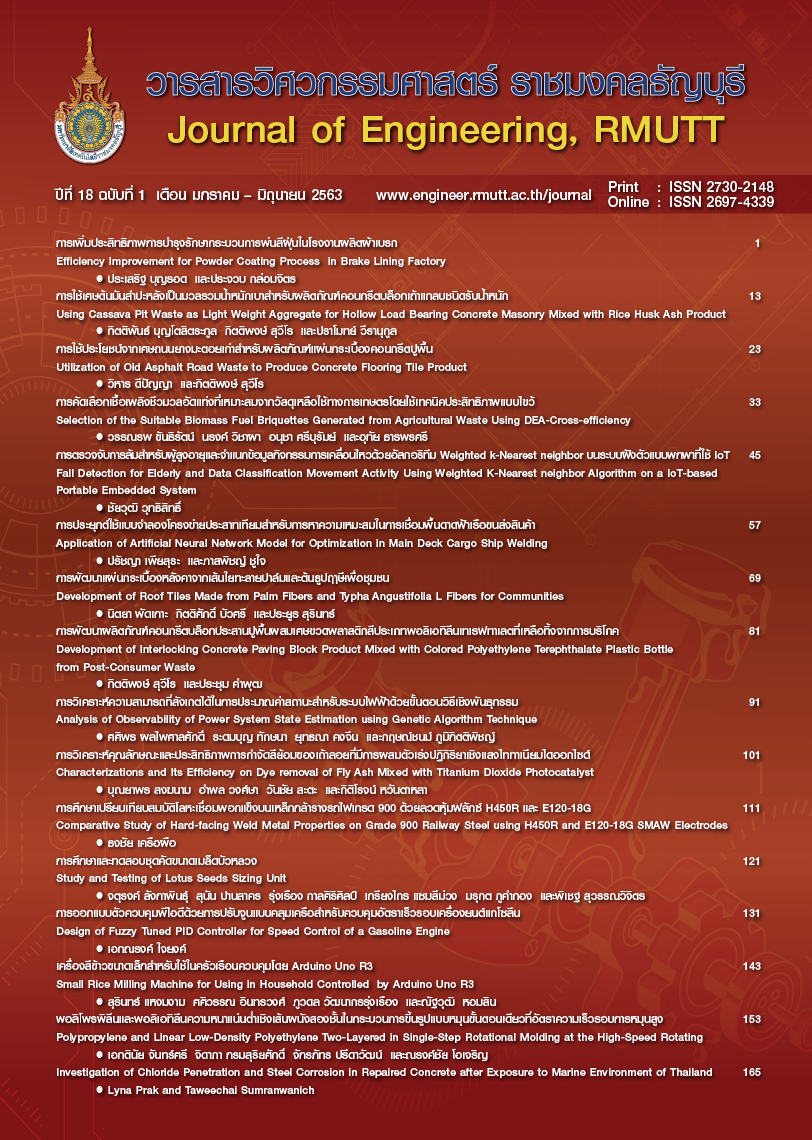Characterizations and Its Efficiency on Dye removal of Fly Ash Mixed with Titanium Dioxide Photocatalyst
Main Article Content
Abstract
The aim of this work was to mix titanium dioxide (TiO2-P25) photocatalyst in contents 0%, 5%, 10% and 15% by weight with coal fly ash from Mae-Moh coal power plant (x%TiO2/FA) mixed by mechanical method for depolluting geo-polymer production. The mixed samples were characterized by X-ray diffraction (XRD), N2 adsorption-desorption, and UV–vis diffuse reflectance spectroscopy (UV-DRS) and studied the Reactive red 120 (RR120) dye degradation efficiency under UV irradiation. The results were found that the crystallinity of anatase and rutile phases increased with increasing TiO2-P25 contents. The specific surface area and pore size increased as well. In addition, the energy band-gap of mixed samples increased from 2.46 to 3.05 eV with increasing photocatalyst contents. Dye degradation studies were tested at initial RR120 concentration 20 ppm and pH 6. The results were found that at 120 min of reaction time, the percent removal of 0%, 5%, 10% and 15% samples were 28.78%, 51.23%, 72.65% and 82.74%, respectively. However, TiO2-P25 photocatalyst can degrade dye about 99.76%. This research can confirm that the mixed samples between coal fly ash from Mae-Moh coal power plant and TiO2 can be used as raw material to produce depolluting geo-polymer for dye degradation.
Article Details
The manuscript, information, content, picture and so forth which were published on Frontiers in engineering innovation research has been a copyright of this journal only. There is not allow anyone or any organize to duplicate all content or some document for unethical publication.
References
Department pollution control.[Internet]. 2019[cite 2019 sep 26];Availablefrom:http://www.pcd.go.th/info_serv/reg_std_water04.html
Teh CY, Budiman PM, Shak KPY, Wu TY. Recent advancement of coagulation-flocculation and Its application inwastewater treatment. Ind Eng Chem Res.2016;55(16):4363–89.
Modrogan C, Miron AR, Orbulet OD, Costache C, Apostol G. Ion exchange processes on weak acid resins for wastewater containing cooper ions treatment. Environ Eng Manag J.2018;14(2):449–54. [4]Lu L, Huang Z, Rau GH, Ren ZJ. Microbial electrolytic carbon capture for carbon negative and energy positive waste-water treatment. Environ Sci Technol. 2015;49(13):8193–201.
Abdel-Kader AM. Studying the efficiency of grey water treatment by using rotating biological contactors system. J King Saud Univ -Eng Sci. 2013;25(2):89–95.
Das R, Ali ME, Hamid SBA, Ramakrishna S, Chowdhury ZZ. Carbon nanotube membranes for water purification: A bright future in water desalination.Desalination. 2014;336(1):97–109.
Han Y, Xu Z, Gao C. Ultrathin graphene nanofiltration membrane for water purification. Adv Funct Mater. 2013;23(29):3693–700.
Gupta VK, Jain R, Mittal A, Saleh TA, Nayak A, Agarwal S, et al. Photocatalytic degradation of toxic dye amaranth on TiO2/UV in aqueous suspensions. Mater Sci Eng C. 2012;32(1):12–7.
Shavisi Y, Sharifnia S, Hosseini SN, Khadivi MA. Application of TiO2/perlitephotocatalysis for degradation ofammonia in wastewater. J Ind EngChem. 2014;20(1):278–83.
Zhao D, Sheng G, Chen C, Wang X.Enhanced photocatalytic degradation of methylene blue under visibleirradiation on graphene@TiO2dyedestructure. Appl Catal B Environ.2012;111–112:303–8.
Zhang Z, Xu Y, Ma X, Li F, Liu D, Chen Z, etal. Microwave degradation of methyl orange dye in aqueous solution in the presence of nano-TiO2supportedactivated carbon (supported-TiO2/AC/MW).J Hazard Mater. 2012;209–210:271–7.
Duta A, Visa M. Simultaneous removal of two industrialdyes by adsorption and photocatalysis on a fly-ash-TiO2composite. J Photochem Photobiol A Chem. 2015;306:21–30.
Al-Harbi LM, Kosa SA, Abd El Maksod IH, Hegazy EZ. The photocatalytic activity of TiO2-zeolite composite for degradationof dye using synthetic UV and Jeddah sunlight. J Nanomater. 2015;1-7. [14]Fatimah I, Said A, Hasanah UA. Preparation of TiO2-SiO2using rice husk ash as silica source and the kinetics study as photocatalyst in methyl violetdecolorization. Bull Chem React Eng Catal. 2015;10(1):43–9.
Electricity generating authority of Thailand[Internet].2019[cite 2019 sep 26];Availablefrom:http://maemoh.egat.com/index.php?option=com_content&view=article&id=89:sarat1&catid=89&Itemid=435.
Ökte AN, Karamanis D, Tuncel D. Dualfunctionality of TiO2-flyash nanocomposites:Water vapor adsorption and photocatalysis.Catal Today. 2014;230:205–13.
Visa M, Isac L, Duta A. New fly ash TiO2composite for the sustainable treatmentof wastewater with complex pollutantsload. Appl Surf Sci. 2015;339(1):62–8.
Shi Z, Yao S, Sui C. Application of fly ash supported titanium dioxide for phenol photodegradation in aqueous solution. Catal Sci Technol. 2011;1(5):817–22.
Saud PS, Pant B, Park M, Chae SH, Park SJ, Ei-Newehy M, et al. Preparation and photocatalytic activity of fly ashincorporated TiO2nanofibers for effective removal of organic pollutants.Ceram Int. 2015;41(1):1771–7.
Ganji N, Allahverdi A, NaeimpoorF, Mahinroosta M. Photocatalytic effect of nano-TiO2loaded cement on dye decolorization and Escherichia coli inactivation under UV irradiation. Res Chem Intermed. 2016;42(6):5395–412.
Strini A, Roviello G, Ricciotti L, Ferone C, Messina F, Schiavi L, et al. TiO2-based photocatalytic geopolymers for nitric oxide degradation. Materials (Basel). 2016;9(7):1–13.
Versus T, Calcination TA. Geopolymer-TiO2Nanocomposites for Photocsatalysis: Synthesis by One-Step Adding TreatmentVersus Two-Step Acidification Calcination.Mineral 2019;9:658-64.
Banerjee S, Sharma GC, Chattopadhyaya MC, Sharma YC. Kinetic and equilibrium modeling for the adsorptive removal of methylene blue from aqueous solutions on of activated fly ash(AFSH). J Environ Chem Eng. 2014;2(3):1870–80.
M Ramazani, M Farahmandjou TF. Effect of Nitric acid on Particle Morphology of the Nano-TiO2. Int J NanosciNanotechnol. 2015;11(2):115–22.
Zuo R, Du G, Zhang W, Liu L, Liu Y, Mei L, et al. Photocatalytic degradation of methylene blue using TiO2impregnateddiatomite. Adv Mater Sci Eng. 2014;1-7.
Suwannaruang T, Kidkhunthod P, Chanlek N, Soontaranon S, Wantala K. High anatase purity of nitrogen-doped TiO2nanorice particles for thephotocatalytic treatment activity ofpharmaceutical wastewater. Appl Surf Sci. 2019;478(October 2018):1–14.
Pant B, Ojha GP, Kim HY, Park M, Park SJ. Fly-ash-incorporated electrospun zinc oxide nanofibers: Potential material for environmental remediation. EnvironPollut. 2019;245:163–72.
Djellabi R, Ghorab MF, Cerrato G, Morandi S, Gatto S, Oldani V, et al. Photoactive TiO2-montmorillonite composite fordegradation of organic dyes in water. J Photochem Photobiol AChem. 2015;295:57–63.
BelHadjltaief H, Ben Zina M, Galvez ME, Da Costa P. Photocatalytic degradation of methyl green dye in aqueous solution over natural clay-supported ZnO-TiO2catalysts. J Photochem Photobiol A Chem. 2016;315:25–33.
Li ZD, Wang HL, Wei XN, Liu XY, Yang YF, Jiang WF. Preparation and photocatalyticperformance of magnetic Fe3O4@TiO2core-shell microspheres supported by silica aerogels from industrial fly ash. J Alloys Compd. 2016;659:240–7.
Wang HL, Qi HP, Wei XN, Liu XY, Jiang WF. Photocatalytic activity of TiO2supported SiO2-Al2O3aerogels preparedfrom industrial fly ash. Cuihua Xuebao/Chinese J Catal. 2016;37(11):2025–33.

